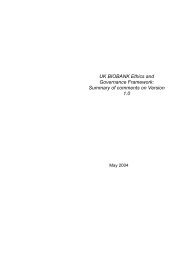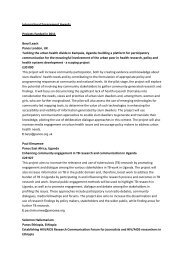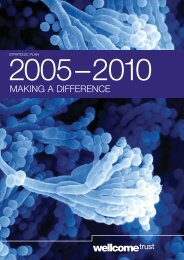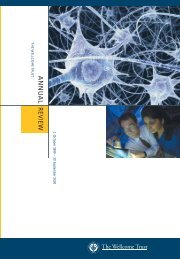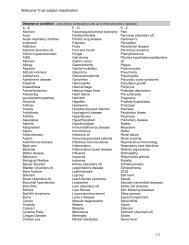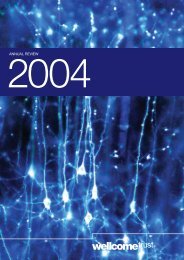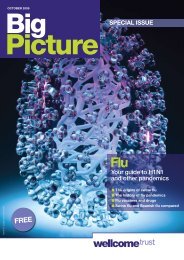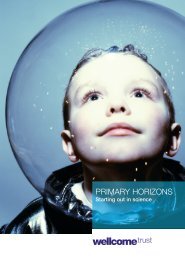You also want an ePaper? Increase the reach of your titles
YUMPU automatically turns print PDFs into web optimized ePapers that Google loves.
6 | advancing Knowledge<br />
Brain waves<br />
Brain imaging is revealing distinctive brain activity<br />
in people with psychological disorders.<br />
Shaking the<br />
Haystack<br />
It’s bonanza time for<br />
genome-wide analyses.<br />
1<br />
2<br />
Abnormal behaviour is seen in many<br />
mental conditions and presumably<br />
reflects disruptions to normal brain<br />
function. Insight into these<br />
abnormalities is being gathered by<br />
brain imaging – increasing<br />
understanding and raising hopes of<br />
better diagnosis and treatment.<br />
The basis of conditions such as<br />
obsessive–compulsive disorder (OCD)<br />
has been difficult to trace, in part<br />
because human behaviours are tricky to<br />
categorise in a way that makes them<br />
amenable to study. A productive way<br />
forward, being taken by Sam Chamberlain<br />
and colleagues in Cambridge, is to identify<br />
patterns of brain activity that can act as<br />
robust proxies of behavioural traits.<br />
To this end, they looked at brain activity<br />
in people with OCD and their unaffected<br />
relatives, who might be expected to<br />
show similar but less marked<br />
abnormalities. Indeed, compared with<br />
controls, activity in areas within the<br />
frontal lobes – known to be involved in<br />
decision-making – were lower in both<br />
people with OCD and their relatives.<br />
Neural correlates of another mental<br />
disorder, depression, have been<br />
uncovered by Cynthia Fu and colleagues<br />
from the Institute of Psychiatry, London.<br />
Ultimately, this may lead to more<br />
objective diagnosis of depression.<br />
Responses were recorded to faces<br />
manipulated digitally to show varying<br />
degrees of sadness. By analysing activity<br />
across the whole brain, Dr Fu was able to<br />
identify patterns consistently seen in<br />
people with depression but not controls.<br />
Finally, Senior Research Fellow Paul<br />
Fletcher and colleagues in Cambridge<br />
have used brain imaging to explore<br />
susceptibility to schizophrenia, using<br />
ketamine to induce a state of psychosis<br />
in healthy volunteers.<br />
Brain activity was monitored in volunteers<br />
before and after a dose of ketamine.<br />
Some distinctive brain activations seen<br />
before ketamine was administered were<br />
significantly more common in those<br />
reporting psychotic symptoms. Moreover,<br />
activation at certain sites seemed to<br />
predict which types of symptom an<br />
individual experienced.<br />
It may therefore be possible to use brain<br />
imaging to identify vulnerabilities to<br />
particular psychotic symptoms, before<br />
they become clinically apparent.<br />
Chamberlain SR et al. Orbitofrontal dysfunction in<br />
patients with obsessive-compulsive disorder and their<br />
unaffected relatives. Science 2008;321(5887):421–2.<br />
Fu CH et al. Pattern classification of sad facial processing:<br />
toward the development of neurobiological markers in<br />
depression. Biol Psychiatry 2008;63(7):656–62.<br />
Honey GD et al. Individual differences in psychotic<br />
effects of ketamine are predicted by brain function<br />
measured under placebo. J Neurosci<br />
2008;28(25):6295–303.<br />
Last year saw a significant advance in<br />
the genetic analysis of common<br />
diseases, with a flood of papers from<br />
the <strong>Wellcome</strong> <strong>Trust</strong> Case Control<br />
Consortium. A further outpouring of<br />
findings has followed this year, as<br />
other groups and consortia have<br />
applied whole-genome approaches<br />
to a range of conditions.<br />
Genome-wide association studies are<br />
taking advantage of high-throughput<br />
genotyping techniques to screen the<br />
entire genome of large numbers of<br />
individuals, to identify sites in the genome<br />
that may be contributing to a disease.<br />
This year saw a whole host of studies<br />
published dissecting conditions as<br />
varied as osteoporosis, ankylosing<br />
spondylitis, psoriasis, Crohn’s disease<br />
and type 2 diabetes.<br />
The latest Crohn’s research identified 21<br />
new risk genes, bringing the total to more<br />
than 30 – though collectively they explain<br />
only about a fifth of the total genetic risk.<br />
This suggests that many additional<br />
genes contribute to Crohn’s, and also<br />
illustrates how complex the condition is.<br />
The studies also picked up unexpected<br />
connections between diseases – one<br />
gene increases susceptibility to both<br />
Crohn’s and psoriasis, another<br />
contributes to both Crohn’s and asthma.<br />
As well as disease, genome-wide studies<br />
have also shed light on other biological<br />
Images<br />
1 Areas of abnormal brain activity (blue) in people with OCD or<br />
their relatives undertaking a cognitive task.<br />
2 Clinical depression may be associated with specific patterns<br />
of brain activity.<br />
3 Large numbers of people can be genotyped in<br />
high-throughput facilities.<br />
4 Embryonic stem cells.




